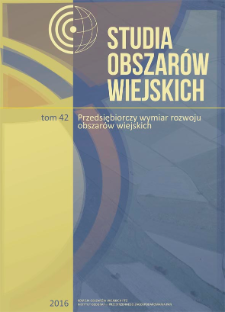- Search in all Repository
- Literature and maps
- Archeology
- Mills database
- Natural sciences
Advanced search
Advanced search
Advanced search
Advanced search
Advanced search

Object
Title: Stan i przyszłość gospodarstw ekologicznych w drobnoobszarowym rolnictwie województwa małopolskiego = Innovation in fragmented agriculture on the example of organic farms in the Małopolskie Voivodship
Subtitle:
Studia Obszarów Wiejskich = Rural Studies, t. 42
Publisher:
Place of publishing:
Type of object:
Abstract:
The Małopolskie Voivodship is characterized by a very low concentration of agriculture, with slowly transforming structure and modernization of production methods. A large part of the smallest farms resign from conducting farming activity and managing animal husbandries. This leads to decreased effectiveness of the agricultural sector in the region and limits facilitation of the existing labor force, the resources of agricultural land and the capital involved in this sector. Nevertheless, innovative activities are undertaken in this region consisting in development of multifunctional agriculture and organizing ecological or agritourism farms or farms which manufacture agricultural products with traditional methods (regional products). In this thesis, the author has focused on organization and operation of ecological farms which amount to nearly 2 thousand in the Małopolskie Voivodship. They constitute 9% of ecological farms in the entire country. Their existence and fast development may be treated as a significant direction of agricultural transformations in the national scale. The paper includes an analysis of the quantitative dynamics of such farms, as well as a characteristics of preconditions for their development in various conditions, both in terms of natural environment and socio-economic aspects. Furthermore, the main issues related to production, sales and processing have been described. The author has also made an effort to present their perspective as one of the methods of revitalizing agriculture in the region. To a large extent, the thesis is based on the author’s own research conducted at the ecological farms operating in the Małopolskie Voiviodship.
References:
1. Gil A., 2014, Współczesne funkcje rolnictwa Małopolski, [w:] R. Rudnicki, M. Kluba (red.), Zintegrowany rozwój obszarów wiejskich w świetle polityki Unii Europejskiej, 1, Rolnictwo i Wspólna Polityka Rolna, Wydawnictwo Naukowe Uniwersytetu Mikołaja Kopernika, Toruń, s. 149–170.
2. Głębocki B. (red), 2014, Zróżnicowanie przestrzenne rolnictwa. Powszechny Spis Rolny 2010, Główny Urząd Statystyczny, Warszawa.
3. Górz B., 2004, Współczesne przemiany na obszarach wiejskich południowo-wschodniej Polski, Studia Obszarów Wiejskich, 6, s. 197–218.
4. Guzik C., Leśnicki J., 2003, Development of rural settlement in Podhale, Prace Geograficzne 112, IGiGP UJ, Kraków.
5. Hasiński W., Grykień S., 2003, Bariery rozwoju rolnictwa ekologicznego na Dolnym Śląsku, [w:] B. Górz, Cz. Guzik (red), Współczesne przekształcenia i przyszłość polskiej wsi, PTG, Uniwersytet Jagielloński, Kraków, s. 111–122.
6. Szymona J., 2013, Szanse i zagrożenia polskiego rolnictwa ekologicznego w perspektywie lat 2014–2020, Kancelaria Senatu, Warszawa.
7. Zegar J. St., 2008, Gospodarstwa ekologiczne w rolnictwie indywidualnym, Wiadomości Statystyczne, 8, s. 49–61.
Relation:
Volume:
Start page:
End page:
Detailed Resource Type:
Format:
File size 1,0 MB ; application/pdf
Resource Identifier:
oai:rcin.org.pl:61626 ; 1642-4689 ; 10.7163/SOW.42.15
Source:
CBGiOŚ. IGiPZ PAN, call no. Cz.4488 ; CBGiOŚ. IGiPZ PAN, call no. Cz.4489 ; click here to follow the link
Language:
Language of abstract:
Rights:
Creative Commons Attribution BY 3.0 PL license
Terms of use:
Copyright-protected material. [CC BY 3.0 PL] May be used within the scope specified in Creative Commons Attribution BY 3.0 PL license, full text available at: ; -
Digitizing institution:
Institute of Geography and Spatial Organization of the Polish Academy of Sciences
Original in:
Projects co-financed by:
Programme Innovative Economy, 2010-2014, Priority Axis 2. R&D infrastructure ; European Union. European Regional Development Fund
Access:
Object collections:
- Digital Repository of Scientific Institutes > Partners' collections > Institute of Geography and Spatial Organization PAS (IGiPZ PAN) > Publications of IGiPZ PAN and employees
- Digital Repository of Scientific Institutes > Partners' collections > Institute of Geography and Spatial Organization PAS (IGiPZ PAN) > Library > Series/Journals/Periodics
- Digital Repository of Scientific Institutes > Literature > Books/Chapters
Last modified:
Oct 2, 2020
In our library since:
Jan 25, 2017
Number of object content downloads / hits:
1187
All available object's versions:
https://rcin.org.pl./publication/80948
Show description in RDF format:
Show description in RDFa format:
Show description in OAI-PMH format:
Objects Similar
Uchmański, Janusz
Grodzińska, Krystyna
Karg, Jerzy
Gliwicz, Joanna

 INSTYTUT ARCHEOLOGII I ETNOLOGII POLSKIEJ AKADEMII NAUK
INSTYTUT ARCHEOLOGII I ETNOLOGII POLSKIEJ AKADEMII NAUK
 INSTYTUT BADAŃ LITERACKICH POLSKIEJ AKADEMII NAUK
INSTYTUT BADAŃ LITERACKICH POLSKIEJ AKADEMII NAUK
 INSTYTUT BADAWCZY LEŚNICTWA
INSTYTUT BADAWCZY LEŚNICTWA
 INSTYTUT BIOLOGII DOŚWIADCZALNEJ IM. MARCELEGO NENCKIEGO POLSKIEJ AKADEMII NAUK
INSTYTUT BIOLOGII DOŚWIADCZALNEJ IM. MARCELEGO NENCKIEGO POLSKIEJ AKADEMII NAUK
 INSTYTUT BIOLOGII SSAKÓW POLSKIEJ AKADEMII NAUK
INSTYTUT BIOLOGII SSAKÓW POLSKIEJ AKADEMII NAUK
 INSTYTUT CHEMII FIZYCZNEJ PAN
INSTYTUT CHEMII FIZYCZNEJ PAN
 INSTYTUT CHEMII ORGANICZNEJ PAN
INSTYTUT CHEMII ORGANICZNEJ PAN
 INSTYTUT FILOZOFII I SOCJOLOGII PAN
INSTYTUT FILOZOFII I SOCJOLOGII PAN
 INSTYTUT GEOGRAFII I PRZESTRZENNEGO ZAGOSPODAROWANIA PAN
INSTYTUT GEOGRAFII I PRZESTRZENNEGO ZAGOSPODAROWANIA PAN
 INSTYTUT HISTORII im. TADEUSZA MANTEUFFLA POLSKIEJ AKADEMII NAUK
INSTYTUT HISTORII im. TADEUSZA MANTEUFFLA POLSKIEJ AKADEMII NAUK
 INSTYTUT JĘZYKA POLSKIEGO POLSKIEJ AKADEMII NAUK
INSTYTUT JĘZYKA POLSKIEGO POLSKIEJ AKADEMII NAUK
 INSTYTUT MATEMATYCZNY PAN
INSTYTUT MATEMATYCZNY PAN
 INSTYTUT MEDYCYNY DOŚWIADCZALNEJ I KLINICZNEJ IM.MIROSŁAWA MOSSAKOWSKIEGO POLSKIEJ AKADEMII NAUK
INSTYTUT MEDYCYNY DOŚWIADCZALNEJ I KLINICZNEJ IM.MIROSŁAWA MOSSAKOWSKIEGO POLSKIEJ AKADEMII NAUK
 INSTYTUT PODSTAWOWYCH PROBLEMÓW TECHNIKI PAN
INSTYTUT PODSTAWOWYCH PROBLEMÓW TECHNIKI PAN
 INSTYTUT SLAWISTYKI PAN
INSTYTUT SLAWISTYKI PAN
 SIEĆ BADAWCZA ŁUKASIEWICZ - INSTYTUT TECHNOLOGII MATERIAŁÓW ELEKTRONICZNYCH
SIEĆ BADAWCZA ŁUKASIEWICZ - INSTYTUT TECHNOLOGII MATERIAŁÓW ELEKTRONICZNYCH
 MUZEUM I INSTYTUT ZOOLOGII POLSKIEJ AKADEMII NAUK
MUZEUM I INSTYTUT ZOOLOGII POLSKIEJ AKADEMII NAUK
 INSTYTUT BADAŃ SYSTEMOWYCH PAN
INSTYTUT BADAŃ SYSTEMOWYCH PAN
 INSTYTUT BOTANIKI IM. WŁADYSŁAWA SZAFERA POLSKIEJ AKADEMII NAUK
INSTYTUT BOTANIKI IM. WŁADYSŁAWA SZAFERA POLSKIEJ AKADEMII NAUK


































